Project: Equality and Diversity in the Workplace at Sainsbury's
VerifiedAdded on 2023/01/19
|28
|5431
|79
Project
AI Summary
This project analyzes the impact of equality and diversity in the workplace, using Sainsbury's as a case study. It begins with an introduction defining diversity and equality and highlighting their importance in achieving organizational goals. The project sets out aims, objectives, and research questions, followed by a literature review that explores the concepts of diversity and equality, strategies used by Sainsbury's, and challenges faced in implementing them. A project management plan is developed, including cost analysis, scope definition, time management, quality control, resource allocation, communication strategies, and risk assessment. The project also includes a Gantt chart and work breakdown structure for effective task management. Furthermore, the project outlines the research methodology, including primary and secondary data collection methods, qualitative and quantitative research approaches. The project aims to provide a comprehensive understanding of diversity and equality in the workplace, offering insights into best practices and challenges, and concluding with recommendations for improving organizational performance. This project is an excellent resource for students studying leadership and management, providing practical examples and theoretical frameworks.
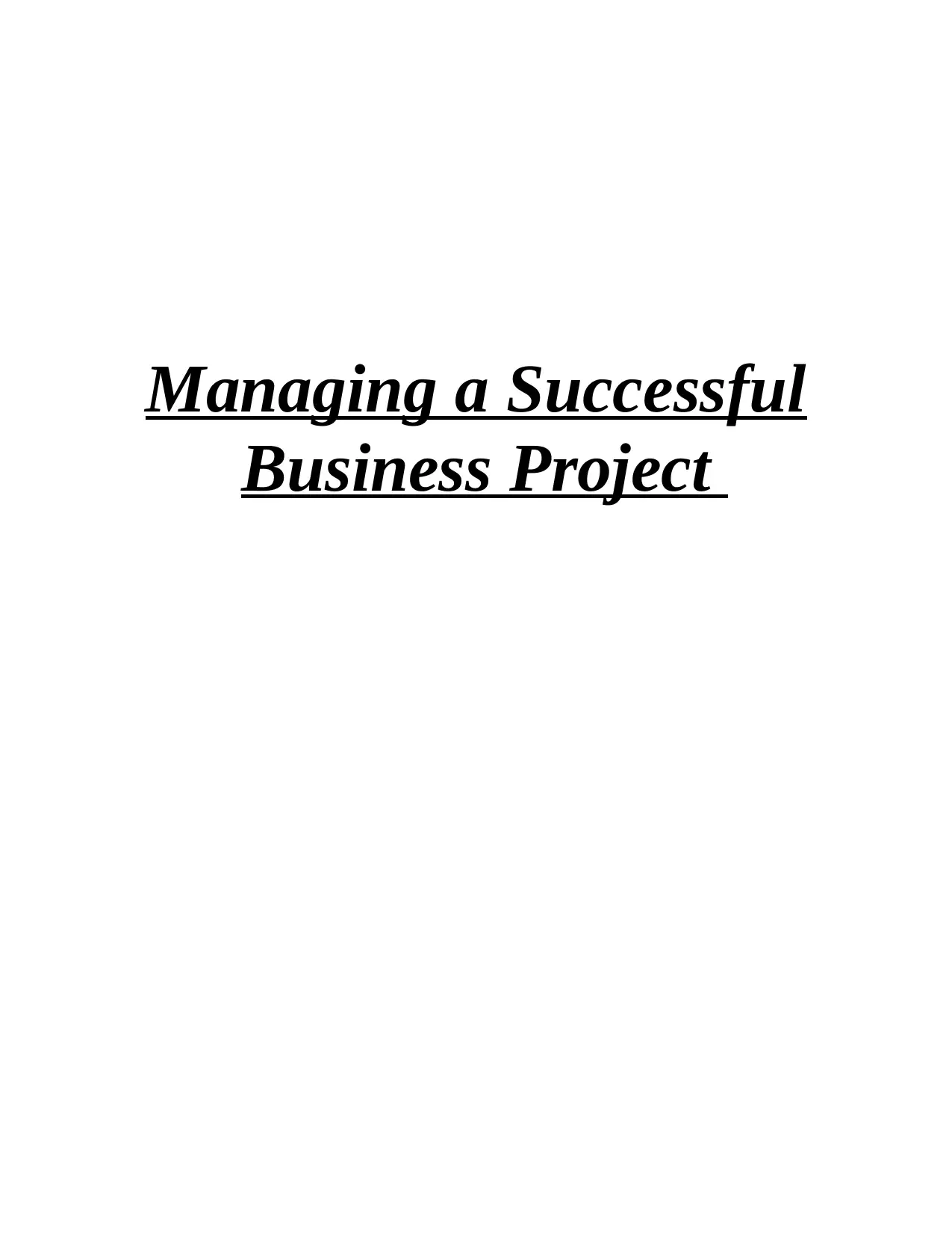
Managing a Successful
Business Project
Business Project
Paraphrase This Document
Need a fresh take? Get an instant paraphrase of this document with our AI Paraphraser
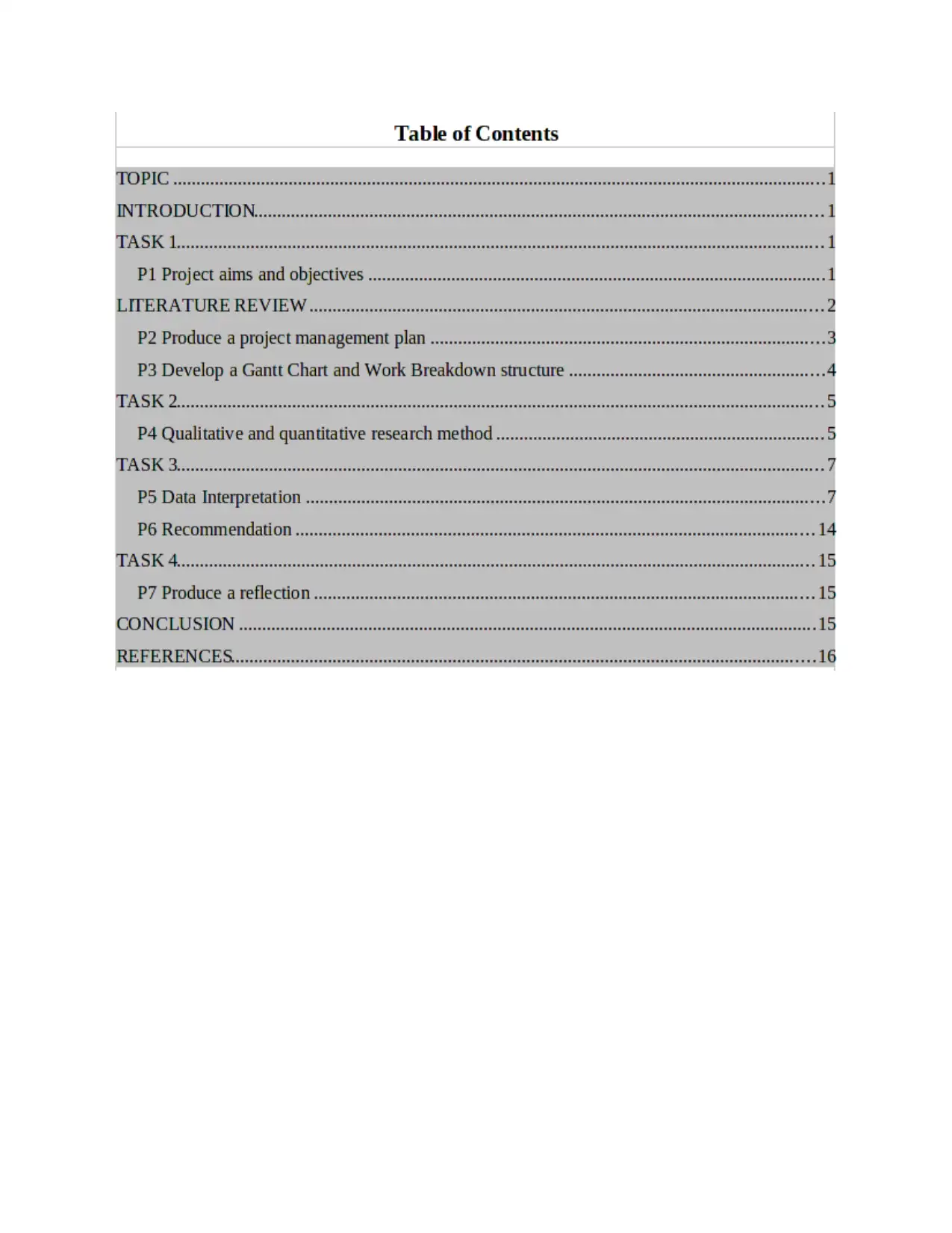
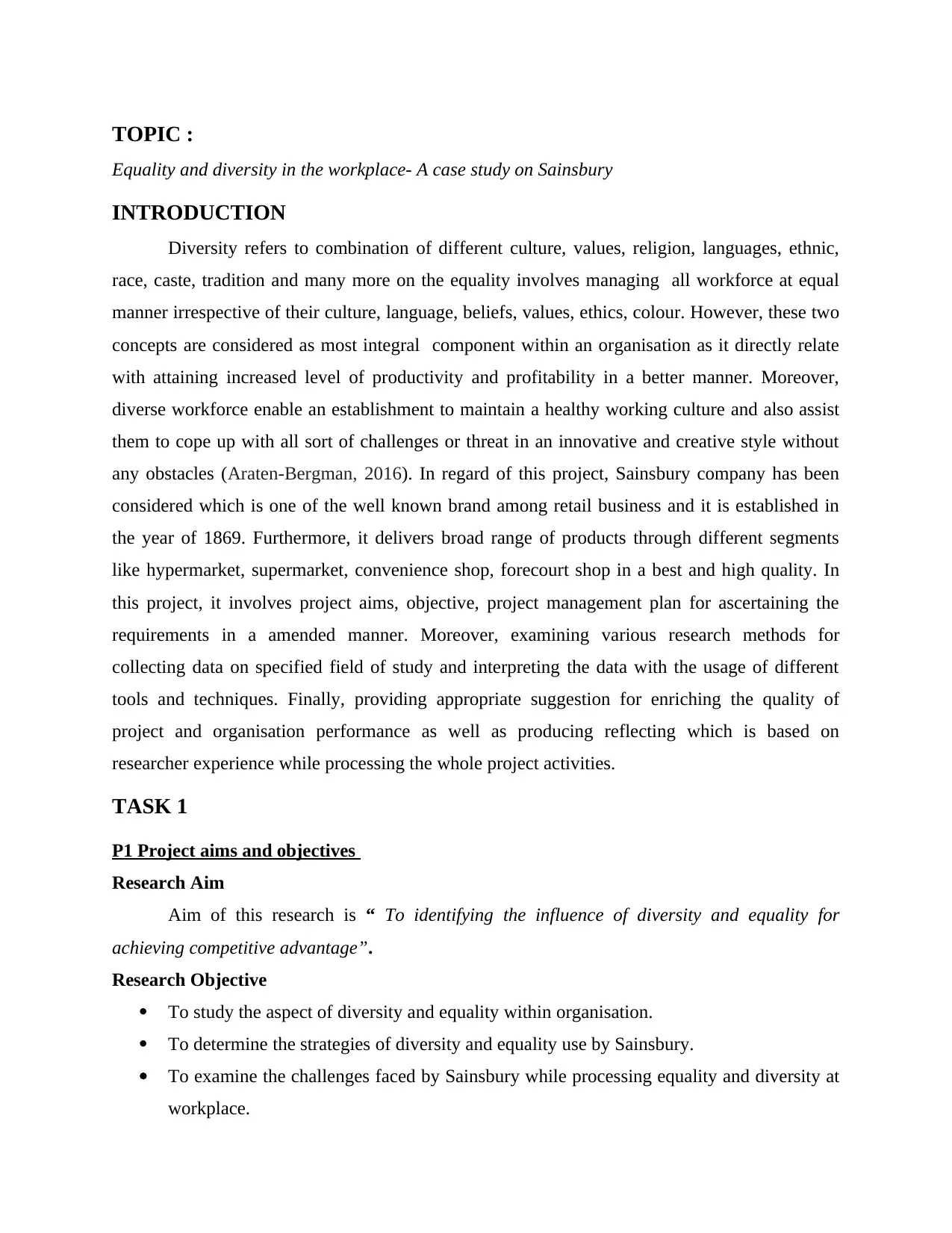
TOPIC :
Equality and diversity in the workplace- A case study on Sainsbury
INTRODUCTION
Diversity refers to combination of different culture, values, religion, languages, ethnic,
race, caste, tradition and many more on the equality involves managing all workforce at equal
manner irrespective of their culture, language, beliefs, values, ethics, colour. However, these two
concepts are considered as most integral component within an organisation as it directly relate
with attaining increased level of productivity and profitability in a better manner. Moreover,
diverse workforce enable an establishment to maintain a healthy working culture and also assist
them to cope up with all sort of challenges or threat in an innovative and creative style without
any obstacles (Araten-Bergman, 2016). In regard of this project, Sainsbury company has been
considered which is one of the well known brand among retail business and it is established in
the year of 1869. Furthermore, it delivers broad range of products through different segments
like hypermarket, supermarket, convenience shop, forecourt shop in a best and high quality. In
this project, it involves project aims, objective, project management plan for ascertaining the
requirements in a amended manner. Moreover, examining various research methods for
collecting data on specified field of study and interpreting the data with the usage of different
tools and techniques. Finally, providing appropriate suggestion for enriching the quality of
project and organisation performance as well as producing reflecting which is based on
researcher experience while processing the whole project activities.
TASK 1
P1 Project aims and objectives
Research Aim
Aim of this research is “ To identifying the influence of diversity and equality for
achieving competitive advantage”.
Research Objective
To study the aspect of diversity and equality within organisation.
To determine the strategies of diversity and equality use by Sainsbury.
To examine the challenges faced by Sainsbury while processing equality and diversity at
workplace.
Equality and diversity in the workplace- A case study on Sainsbury
INTRODUCTION
Diversity refers to combination of different culture, values, religion, languages, ethnic,
race, caste, tradition and many more on the equality involves managing all workforce at equal
manner irrespective of their culture, language, beliefs, values, ethics, colour. However, these two
concepts are considered as most integral component within an organisation as it directly relate
with attaining increased level of productivity and profitability in a better manner. Moreover,
diverse workforce enable an establishment to maintain a healthy working culture and also assist
them to cope up with all sort of challenges or threat in an innovative and creative style without
any obstacles (Araten-Bergman, 2016). In regard of this project, Sainsbury company has been
considered which is one of the well known brand among retail business and it is established in
the year of 1869. Furthermore, it delivers broad range of products through different segments
like hypermarket, supermarket, convenience shop, forecourt shop in a best and high quality. In
this project, it involves project aims, objective, project management plan for ascertaining the
requirements in a amended manner. Moreover, examining various research methods for
collecting data on specified field of study and interpreting the data with the usage of different
tools and techniques. Finally, providing appropriate suggestion for enriching the quality of
project and organisation performance as well as producing reflecting which is based on
researcher experience while processing the whole project activities.
TASK 1
P1 Project aims and objectives
Research Aim
Aim of this research is “ To identifying the influence of diversity and equality for
achieving competitive advantage”.
Research Objective
To study the aspect of diversity and equality within organisation.
To determine the strategies of diversity and equality use by Sainsbury.
To examine the challenges faced by Sainsbury while processing equality and diversity at
workplace.
⊘ This is a preview!⊘
Do you want full access?
Subscribe today to unlock all pages.

Trusted by 1+ million students worldwide
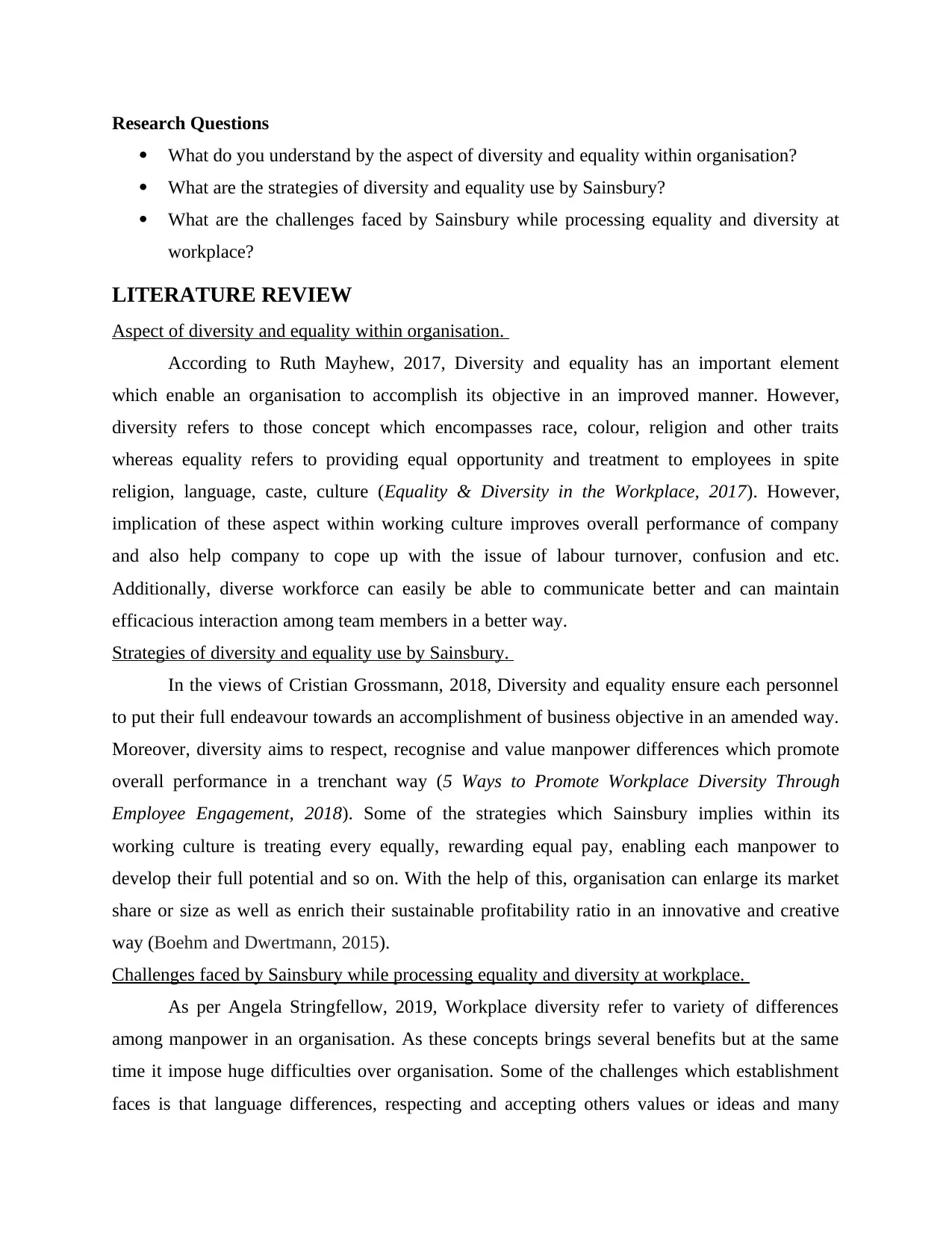
Research Questions
What do you understand by the aspect of diversity and equality within organisation?
What are the strategies of diversity and equality use by Sainsbury?
What are the challenges faced by Sainsbury while processing equality and diversity at
workplace?
LITERATURE REVIEW
Aspect of diversity and equality within organisation.
According to Ruth Mayhew, 2017, Diversity and equality has an important element
which enable an organisation to accomplish its objective in an improved manner. However,
diversity refers to those concept which encompasses race, colour, religion and other traits
whereas equality refers to providing equal opportunity and treatment to employees in spite
religion, language, caste, culture (Equality & Diversity in the Workplace, 2017). However,
implication of these aspect within working culture improves overall performance of company
and also help company to cope up with the issue of labour turnover, confusion and etc.
Additionally, diverse workforce can easily be able to communicate better and can maintain
efficacious interaction among team members in a better way.
Strategies of diversity and equality use by Sainsbury.
In the views of Cristian Grossmann, 2018, Diversity and equality ensure each personnel
to put their full endeavour towards an accomplishment of business objective in an amended way.
Moreover, diversity aims to respect, recognise and value manpower differences which promote
overall performance in a trenchant way (5 Ways to Promote Workplace Diversity Through
Employee Engagement, 2018). Some of the strategies which Sainsbury implies within its
working culture is treating every equally, rewarding equal pay, enabling each manpower to
develop their full potential and so on. With the help of this, organisation can enlarge its market
share or size as well as enrich their sustainable profitability ratio in an innovative and creative
way (Boehm and Dwertmann, 2015).
Challenges faced by Sainsbury while processing equality and diversity at workplace.
As per Angela Stringfellow, 2019, Workplace diversity refer to variety of differences
among manpower in an organisation. As these concepts brings several benefits but at the same
time it impose huge difficulties over organisation. Some of the challenges which establishment
faces is that language differences, respecting and accepting others values or ideas and many
What do you understand by the aspect of diversity and equality within organisation?
What are the strategies of diversity and equality use by Sainsbury?
What are the challenges faced by Sainsbury while processing equality and diversity at
workplace?
LITERATURE REVIEW
Aspect of diversity and equality within organisation.
According to Ruth Mayhew, 2017, Diversity and equality has an important element
which enable an organisation to accomplish its objective in an improved manner. However,
diversity refers to those concept which encompasses race, colour, religion and other traits
whereas equality refers to providing equal opportunity and treatment to employees in spite
religion, language, caste, culture (Equality & Diversity in the Workplace, 2017). However,
implication of these aspect within working culture improves overall performance of company
and also help company to cope up with the issue of labour turnover, confusion and etc.
Additionally, diverse workforce can easily be able to communicate better and can maintain
efficacious interaction among team members in a better way.
Strategies of diversity and equality use by Sainsbury.
In the views of Cristian Grossmann, 2018, Diversity and equality ensure each personnel
to put their full endeavour towards an accomplishment of business objective in an amended way.
Moreover, diversity aims to respect, recognise and value manpower differences which promote
overall performance in a trenchant way (5 Ways to Promote Workplace Diversity Through
Employee Engagement, 2018). Some of the strategies which Sainsbury implies within its
working culture is treating every equally, rewarding equal pay, enabling each manpower to
develop their full potential and so on. With the help of this, organisation can enlarge its market
share or size as well as enrich their sustainable profitability ratio in an innovative and creative
way (Boehm and Dwertmann, 2015).
Challenges faced by Sainsbury while processing equality and diversity at workplace.
As per Angela Stringfellow, 2019, Workplace diversity refer to variety of differences
among manpower in an organisation. As these concepts brings several benefits but at the same
time it impose huge difficulties over organisation. Some of the challenges which establishment
faces is that language differences, respecting and accepting others values or ideas and many
Paraphrase This Document
Need a fresh take? Get an instant paraphrase of this document with our AI Paraphraser
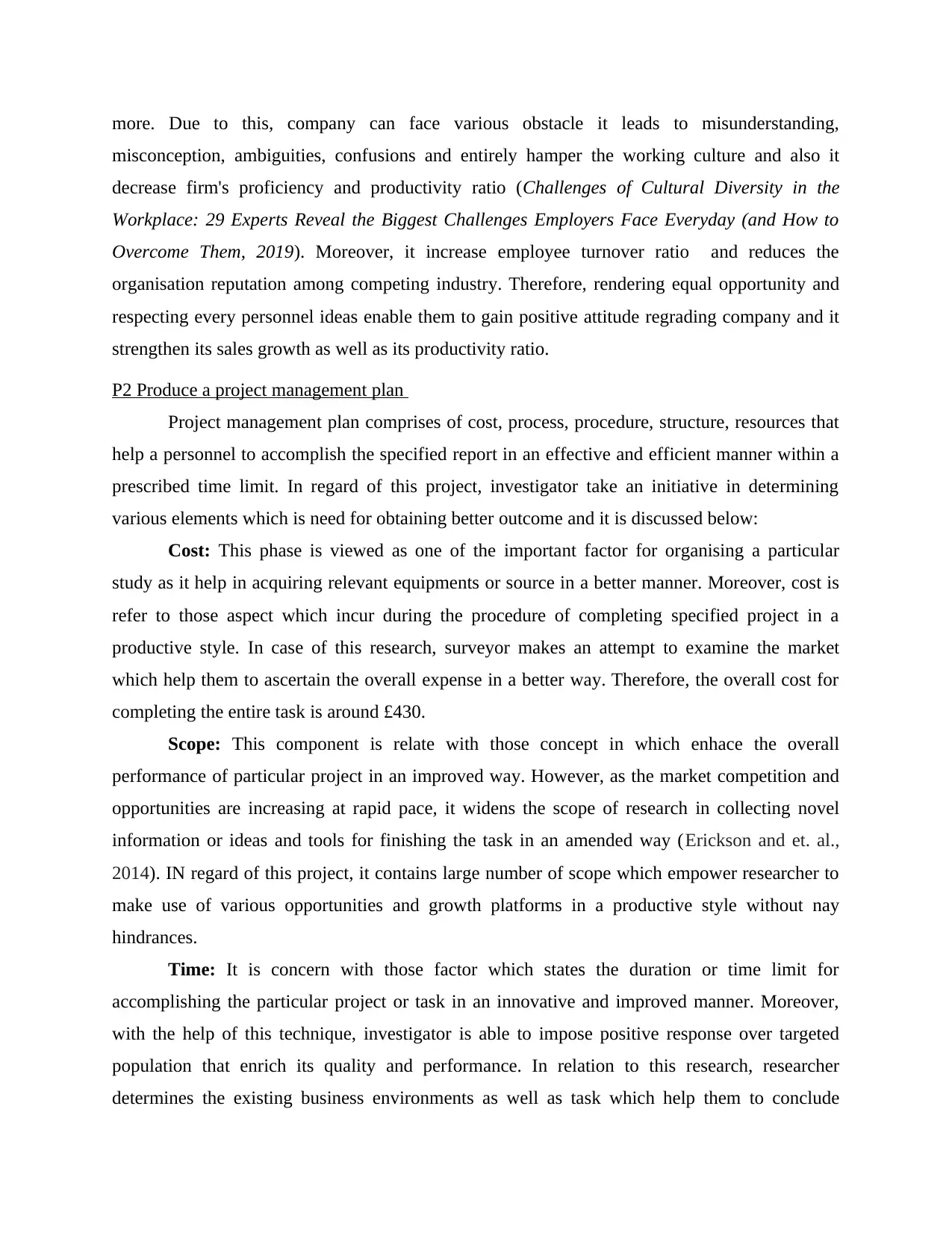
more. Due to this, company can face various obstacle it leads to misunderstanding,
misconception, ambiguities, confusions and entirely hamper the working culture and also it
decrease firm's proficiency and productivity ratio (Challenges of Cultural Diversity in the
Workplace: 29 Experts Reveal the Biggest Challenges Employers Face Everyday (and How to
Overcome Them, 2019). Moreover, it increase employee turnover ratio and reduces the
organisation reputation among competing industry. Therefore, rendering equal opportunity and
respecting every personnel ideas enable them to gain positive attitude regrading company and it
strengthen its sales growth as well as its productivity ratio.
P2 Produce a project management plan
Project management plan comprises of cost, process, procedure, structure, resources that
help a personnel to accomplish the specified report in an effective and efficient manner within a
prescribed time limit. In regard of this project, investigator take an initiative in determining
various elements which is need for obtaining better outcome and it is discussed below:
Cost: This phase is viewed as one of the important factor for organising a particular
study as it help in acquiring relevant equipments or source in a better manner. Moreover, cost is
refer to those aspect which incur during the procedure of completing specified project in a
productive style. In case of this research, surveyor makes an attempt to examine the market
which help them to ascertain the overall expense in a better way. Therefore, the overall cost for
completing the entire task is around £430.
Scope: This component is relate with those concept in which enhace the overall
performance of particular project in an improved way. However, as the market competition and
opportunities are increasing at rapid pace, it widens the scope of research in collecting novel
information or ideas and tools for finishing the task in an amended way (Erickson and et. al.,
2014). IN regard of this project, it contains large number of scope which empower researcher to
make use of various opportunities and growth platforms in a productive style without nay
hindrances.
Time: It is concern with those factor which states the duration or time limit for
accomplishing the particular project or task in an innovative and improved manner. Moreover,
with the help of this technique, investigator is able to impose positive response over targeted
population that enrich its quality and performance. In relation to this research, researcher
determines the existing business environments as well as task which help them to conclude
misconception, ambiguities, confusions and entirely hamper the working culture and also it
decrease firm's proficiency and productivity ratio (Challenges of Cultural Diversity in the
Workplace: 29 Experts Reveal the Biggest Challenges Employers Face Everyday (and How to
Overcome Them, 2019). Moreover, it increase employee turnover ratio and reduces the
organisation reputation among competing industry. Therefore, rendering equal opportunity and
respecting every personnel ideas enable them to gain positive attitude regrading company and it
strengthen its sales growth as well as its productivity ratio.
P2 Produce a project management plan
Project management plan comprises of cost, process, procedure, structure, resources that
help a personnel to accomplish the specified report in an effective and efficient manner within a
prescribed time limit. In regard of this project, investigator take an initiative in determining
various elements which is need for obtaining better outcome and it is discussed below:
Cost: This phase is viewed as one of the important factor for organising a particular
study as it help in acquiring relevant equipments or source in a better manner. Moreover, cost is
refer to those aspect which incur during the procedure of completing specified project in a
productive style. In case of this research, surveyor makes an attempt to examine the market
which help them to ascertain the overall expense in a better way. Therefore, the overall cost for
completing the entire task is around £430.
Scope: This component is relate with those concept in which enhace the overall
performance of particular project in an improved way. However, as the market competition and
opportunities are increasing at rapid pace, it widens the scope of research in collecting novel
information or ideas and tools for finishing the task in an amended way (Erickson and et. al.,
2014). IN regard of this project, it contains large number of scope which empower researcher to
make use of various opportunities and growth platforms in a productive style without nay
hindrances.
Time: It is concern with those factor which states the duration or time limit for
accomplishing the particular project or task in an innovative and improved manner. Moreover,
with the help of this technique, investigator is able to impose positive response over targeted
population that enrich its quality and performance. In relation to this research, researcher
determines the existing business environments as well as task which help them to conclude
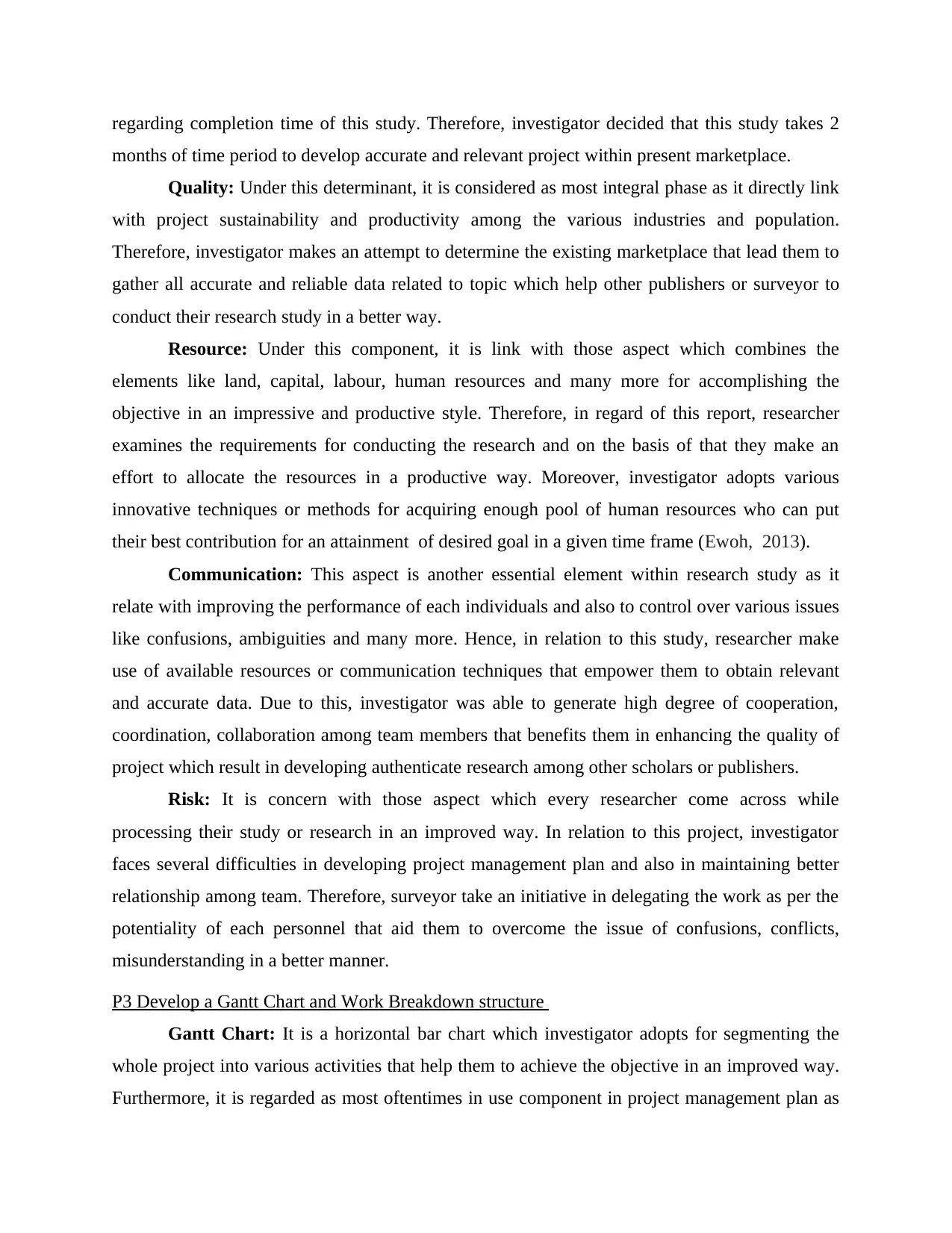
regarding completion time of this study. Therefore, investigator decided that this study takes 2
months of time period to develop accurate and relevant project within present marketplace.
Quality: Under this determinant, it is considered as most integral phase as it directly link
with project sustainability and productivity among the various industries and population.
Therefore, investigator makes an attempt to determine the existing marketplace that lead them to
gather all accurate and reliable data related to topic which help other publishers or surveyor to
conduct their research study in a better way.
Resource: Under this component, it is link with those aspect which combines the
elements like land, capital, labour, human resources and many more for accomplishing the
objective in an impressive and productive style. Therefore, in regard of this report, researcher
examines the requirements for conducting the research and on the basis of that they make an
effort to allocate the resources in a productive way. Moreover, investigator adopts various
innovative techniques or methods for acquiring enough pool of human resources who can put
their best contribution for an attainment of desired goal in a given time frame (Ewoh, 2013).
Communication: This aspect is another essential element within research study as it
relate with improving the performance of each individuals and also to control over various issues
like confusions, ambiguities and many more. Hence, in relation to this study, researcher make
use of available resources or communication techniques that empower them to obtain relevant
and accurate data. Due to this, investigator was able to generate high degree of cooperation,
coordination, collaboration among team members that benefits them in enhancing the quality of
project which result in developing authenticate research among other scholars or publishers.
Risk: It is concern with those aspect which every researcher come across while
processing their study or research in an improved way. In relation to this project, investigator
faces several difficulties in developing project management plan and also in maintaining better
relationship among team. Therefore, surveyor take an initiative in delegating the work as per the
potentiality of each personnel that aid them to overcome the issue of confusions, conflicts,
misunderstanding in a better manner.
P3 Develop a Gantt Chart and Work Breakdown structure
Gantt Chart: It is a horizontal bar chart which investigator adopts for segmenting the
whole project into various activities that help them to achieve the objective in an improved way.
Furthermore, it is regarded as most oftentimes in use component in project management plan as
months of time period to develop accurate and relevant project within present marketplace.
Quality: Under this determinant, it is considered as most integral phase as it directly link
with project sustainability and productivity among the various industries and population.
Therefore, investigator makes an attempt to determine the existing marketplace that lead them to
gather all accurate and reliable data related to topic which help other publishers or surveyor to
conduct their research study in a better way.
Resource: Under this component, it is link with those aspect which combines the
elements like land, capital, labour, human resources and many more for accomplishing the
objective in an impressive and productive style. Therefore, in regard of this report, researcher
examines the requirements for conducting the research and on the basis of that they make an
effort to allocate the resources in a productive way. Moreover, investigator adopts various
innovative techniques or methods for acquiring enough pool of human resources who can put
their best contribution for an attainment of desired goal in a given time frame (Ewoh, 2013).
Communication: This aspect is another essential element within research study as it
relate with improving the performance of each individuals and also to control over various issues
like confusions, ambiguities and many more. Hence, in relation to this study, researcher make
use of available resources or communication techniques that empower them to obtain relevant
and accurate data. Due to this, investigator was able to generate high degree of cooperation,
coordination, collaboration among team members that benefits them in enhancing the quality of
project which result in developing authenticate research among other scholars or publishers.
Risk: It is concern with those aspect which every researcher come across while
processing their study or research in an improved way. In relation to this project, investigator
faces several difficulties in developing project management plan and also in maintaining better
relationship among team. Therefore, surveyor take an initiative in delegating the work as per the
potentiality of each personnel that aid them to overcome the issue of confusions, conflicts,
misunderstanding in a better manner.
P3 Develop a Gantt Chart and Work Breakdown structure
Gantt Chart: It is a horizontal bar chart which investigator adopts for segmenting the
whole project into various activities that help them to achieve the objective in an improved way.
Furthermore, it is regarded as most oftentimes in use component in project management plan as
⊘ This is a preview!⊘
Do you want full access?
Subscribe today to unlock all pages.

Trusted by 1+ million students worldwide
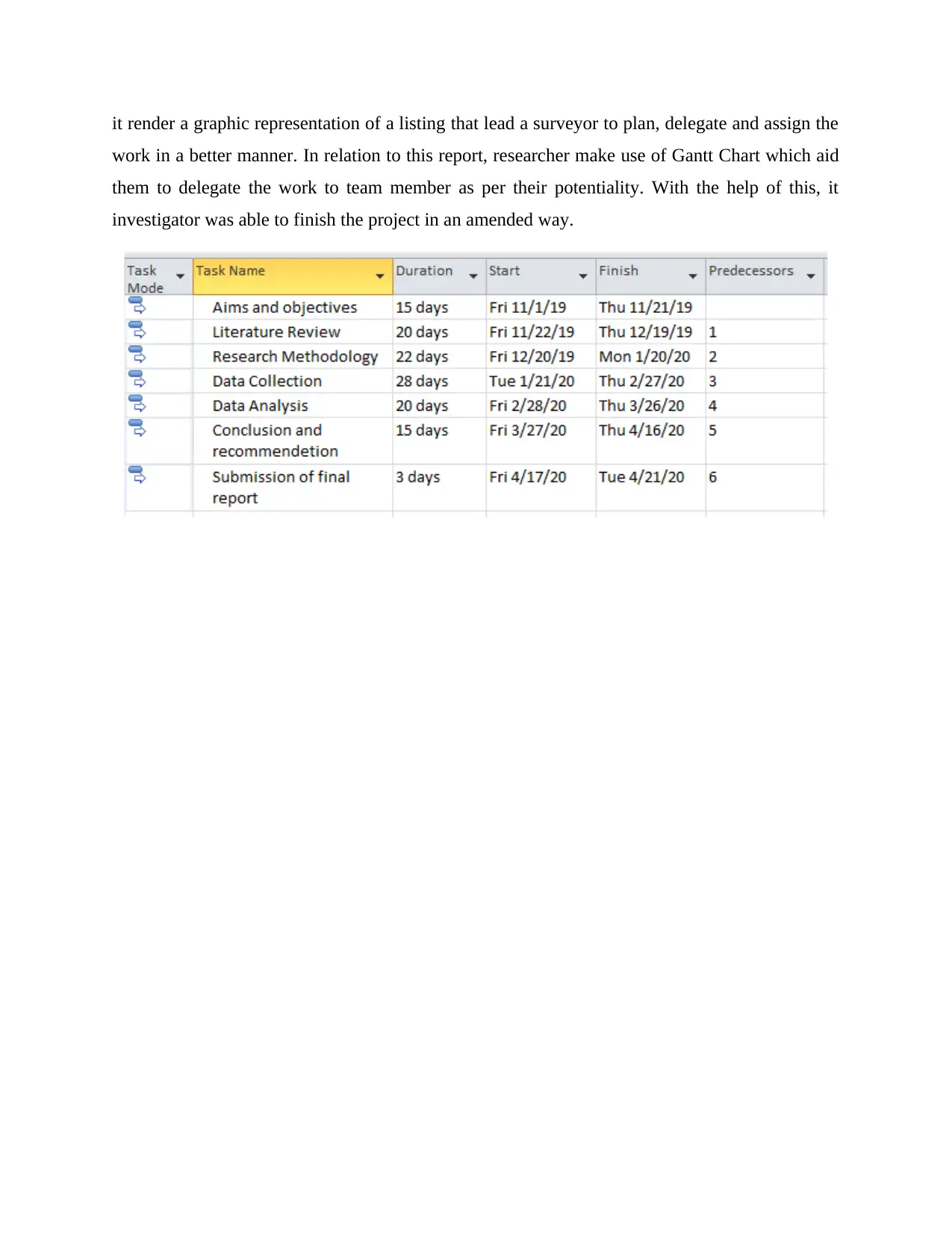
it render a graphic representation of a listing that lead a surveyor to plan, delegate and assign the
work in a better manner. In relation to this report, researcher make use of Gantt Chart which aid
them to delegate the work to team member as per their potentiality. With the help of this, it
investigator was able to finish the project in an amended way.
work in a better manner. In relation to this report, researcher make use of Gantt Chart which aid
them to delegate the work to team member as per their potentiality. With the help of this, it
investigator was able to finish the project in an amended way.
Paraphrase This Document
Need a fresh take? Get an instant paraphrase of this document with our AI Paraphraser
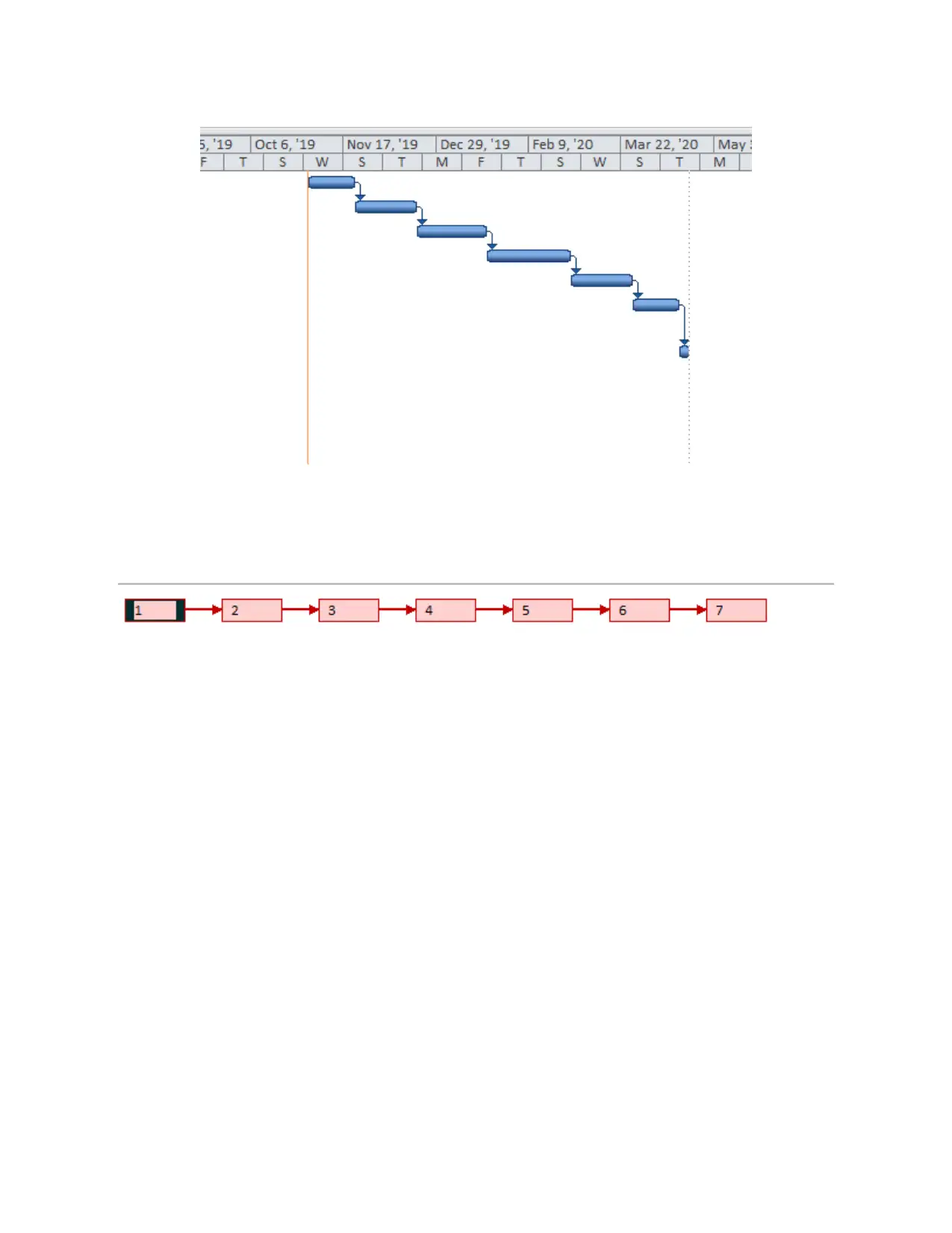
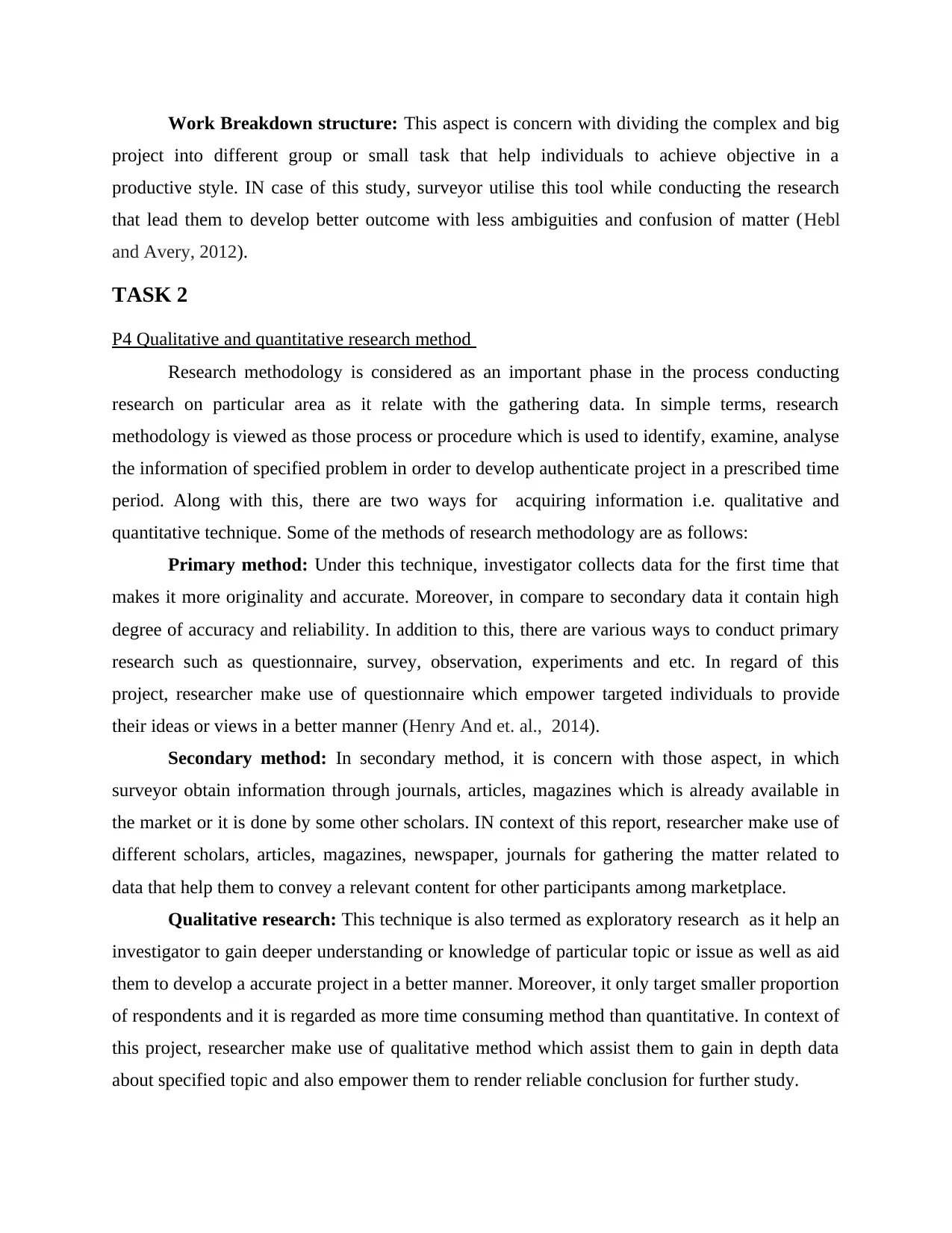
Work Breakdown structure: This aspect is concern with dividing the complex and big
project into different group or small task that help individuals to achieve objective in a
productive style. IN case of this study, surveyor utilise this tool while conducting the research
that lead them to develop better outcome with less ambiguities and confusion of matter (Hebl
and Avery, 2012).
TASK 2
P4 Qualitative and quantitative research method
Research methodology is considered as an important phase in the process conducting
research on particular area as it relate with the gathering data. In simple terms, research
methodology is viewed as those process or procedure which is used to identify, examine, analyse
the information of specified problem in order to develop authenticate project in a prescribed time
period. Along with this, there are two ways for acquiring information i.e. qualitative and
quantitative technique. Some of the methods of research methodology are as follows:
Primary method: Under this technique, investigator collects data for the first time that
makes it more originality and accurate. Moreover, in compare to secondary data it contain high
degree of accuracy and reliability. In addition to this, there are various ways to conduct primary
research such as questionnaire, survey, observation, experiments and etc. In regard of this
project, researcher make use of questionnaire which empower targeted individuals to provide
their ideas or views in a better manner (Henry And et. al., 2014).
Secondary method: In secondary method, it is concern with those aspect, in which
surveyor obtain information through journals, articles, magazines which is already available in
the market or it is done by some other scholars. IN context of this report, researcher make use of
different scholars, articles, magazines, newspaper, journals for gathering the matter related to
data that help them to convey a relevant content for other participants among marketplace.
Qualitative research: This technique is also termed as exploratory research as it help an
investigator to gain deeper understanding or knowledge of particular topic or issue as well as aid
them to develop a accurate project in a better manner. Moreover, it only target smaller proportion
of respondents and it is regarded as more time consuming method than quantitative. In context of
this project, researcher make use of qualitative method which assist them to gain in depth data
about specified topic and also empower them to render reliable conclusion for further study.
project into different group or small task that help individuals to achieve objective in a
productive style. IN case of this study, surveyor utilise this tool while conducting the research
that lead them to develop better outcome with less ambiguities and confusion of matter (Hebl
and Avery, 2012).
TASK 2
P4 Qualitative and quantitative research method
Research methodology is considered as an important phase in the process conducting
research on particular area as it relate with the gathering data. In simple terms, research
methodology is viewed as those process or procedure which is used to identify, examine, analyse
the information of specified problem in order to develop authenticate project in a prescribed time
period. Along with this, there are two ways for acquiring information i.e. qualitative and
quantitative technique. Some of the methods of research methodology are as follows:
Primary method: Under this technique, investigator collects data for the first time that
makes it more originality and accurate. Moreover, in compare to secondary data it contain high
degree of accuracy and reliability. In addition to this, there are various ways to conduct primary
research such as questionnaire, survey, observation, experiments and etc. In regard of this
project, researcher make use of questionnaire which empower targeted individuals to provide
their ideas or views in a better manner (Henry And et. al., 2014).
Secondary method: In secondary method, it is concern with those aspect, in which
surveyor obtain information through journals, articles, magazines which is already available in
the market or it is done by some other scholars. IN context of this report, researcher make use of
different scholars, articles, magazines, newspaper, journals for gathering the matter related to
data that help them to convey a relevant content for other participants among marketplace.
Qualitative research: This technique is also termed as exploratory research as it help an
investigator to gain deeper understanding or knowledge of particular topic or issue as well as aid
them to develop a accurate project in a better manner. Moreover, it only target smaller proportion
of respondents and it is regarded as more time consuming method than quantitative. In context of
this project, researcher make use of qualitative method which assist them to gain in depth data
about specified topic and also empower them to render reliable conclusion for further study.
⊘ This is a preview!⊘
Do you want full access?
Subscribe today to unlock all pages.

Trusted by 1+ million students worldwide
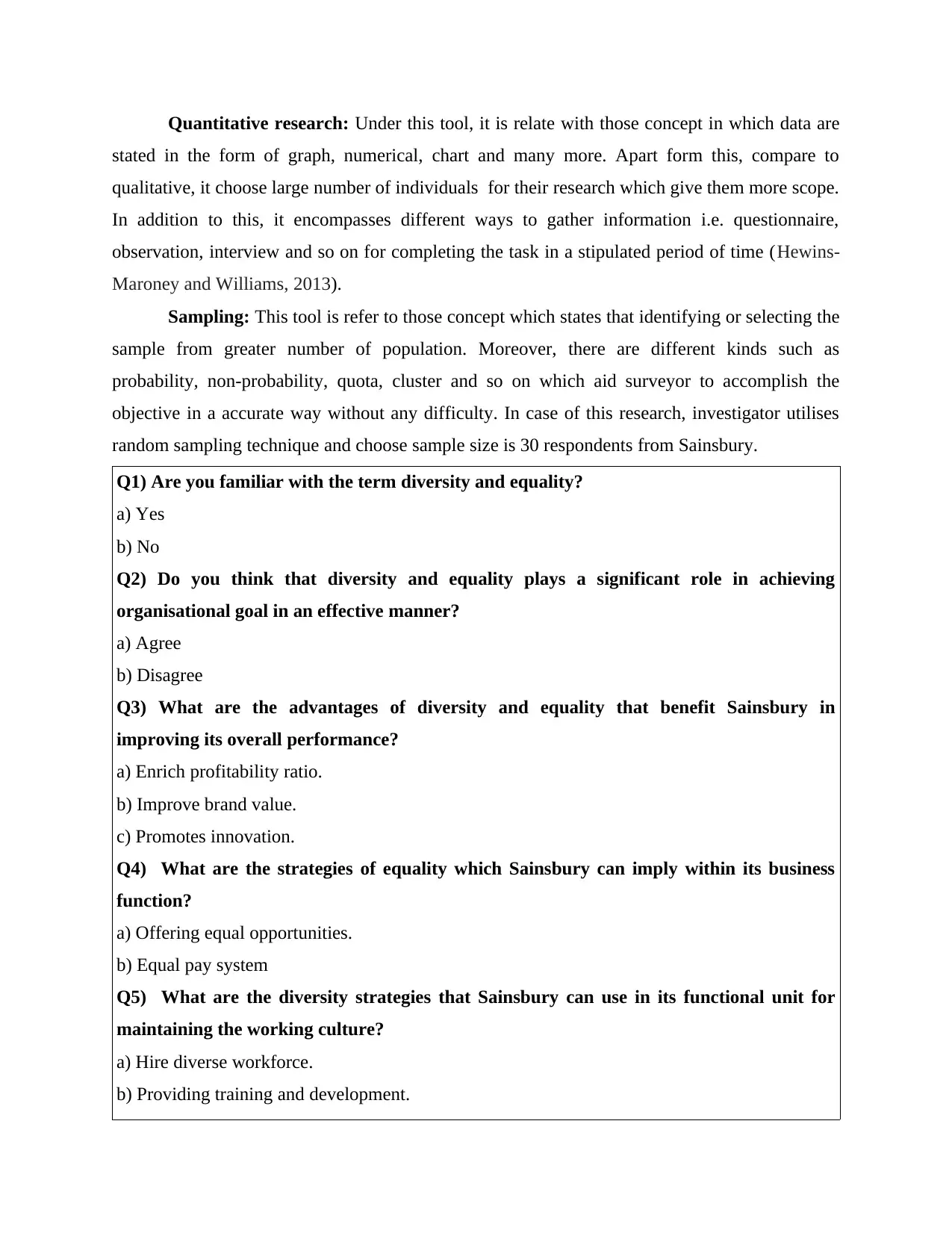
Quantitative research: Under this tool, it is relate with those concept in which data are
stated in the form of graph, numerical, chart and many more. Apart form this, compare to
qualitative, it choose large number of individuals for their research which give them more scope.
In addition to this, it encompasses different ways to gather information i.e. questionnaire,
observation, interview and so on for completing the task in a stipulated period of time (Hewins-
Maroney and Williams, 2013).
Sampling: This tool is refer to those concept which states that identifying or selecting the
sample from greater number of population. Moreover, there are different kinds such as
probability, non-probability, quota, cluster and so on which aid surveyor to accomplish the
objective in a accurate way without any difficulty. In case of this research, investigator utilises
random sampling technique and choose sample size is 30 respondents from Sainsbury.
Q1) Are you familiar with the term diversity and equality?
a) Yes
b) No
Q2) Do you think that diversity and equality plays a significant role in achieving
organisational goal in an effective manner?
a) Agree
b) Disagree
Q3) What are the advantages of diversity and equality that benefit Sainsbury in
improving its overall performance?
a) Enrich profitability ratio.
b) Improve brand value.
c) Promotes innovation.
Q4) What are the strategies of equality which Sainsbury can imply within its business
function?
a) Offering equal opportunities.
b) Equal pay system
Q5) What are the diversity strategies that Sainsbury can use in its functional unit for
maintaining the working culture?
a) Hire diverse workforce.
b) Providing training and development.
stated in the form of graph, numerical, chart and many more. Apart form this, compare to
qualitative, it choose large number of individuals for their research which give them more scope.
In addition to this, it encompasses different ways to gather information i.e. questionnaire,
observation, interview and so on for completing the task in a stipulated period of time (Hewins-
Maroney and Williams, 2013).
Sampling: This tool is refer to those concept which states that identifying or selecting the
sample from greater number of population. Moreover, there are different kinds such as
probability, non-probability, quota, cluster and so on which aid surveyor to accomplish the
objective in a accurate way without any difficulty. In case of this research, investigator utilises
random sampling technique and choose sample size is 30 respondents from Sainsbury.
Q1) Are you familiar with the term diversity and equality?
a) Yes
b) No
Q2) Do you think that diversity and equality plays a significant role in achieving
organisational goal in an effective manner?
a) Agree
b) Disagree
Q3) What are the advantages of diversity and equality that benefit Sainsbury in
improving its overall performance?
a) Enrich profitability ratio.
b) Improve brand value.
c) Promotes innovation.
Q4) What are the strategies of equality which Sainsbury can imply within its business
function?
a) Offering equal opportunities.
b) Equal pay system
Q5) What are the diversity strategies that Sainsbury can use in its functional unit for
maintaining the working culture?
a) Hire diverse workforce.
b) Providing training and development.
Paraphrase This Document
Need a fresh take? Get an instant paraphrase of this document with our AI Paraphraser
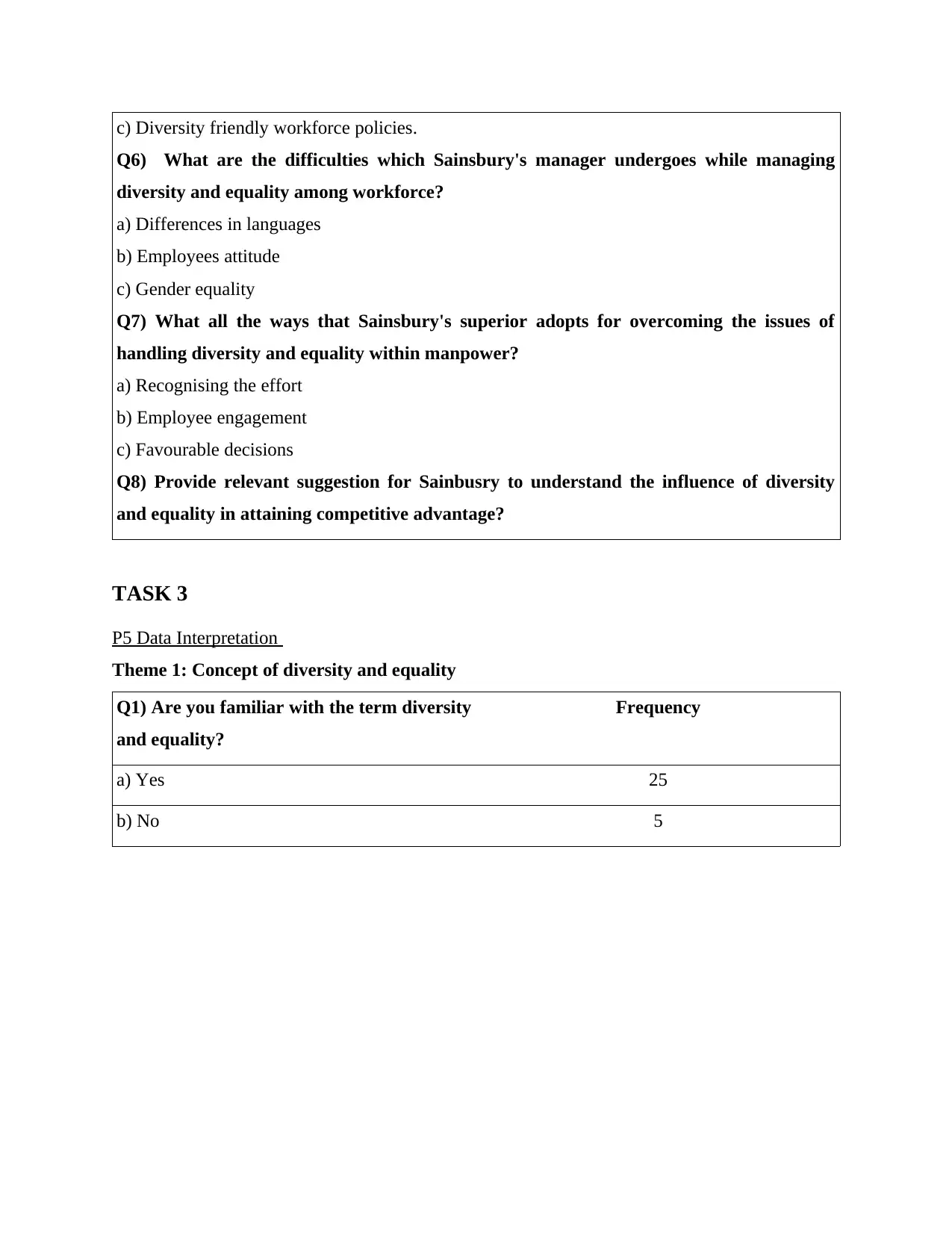
c) Diversity friendly workforce policies.
Q6) What are the difficulties which Sainsbury's manager undergoes while managing
diversity and equality among workforce?
a) Differences in languages
b) Employees attitude
c) Gender equality
Q7) What all the ways that Sainsbury's superior adopts for overcoming the issues of
handling diversity and equality within manpower?
a) Recognising the effort
b) Employee engagement
c) Favourable decisions
Q8) Provide relevant suggestion for Sainbusry to understand the influence of diversity
and equality in attaining competitive advantage?
TASK 3
P5 Data Interpretation
Theme 1: Concept of diversity and equality
Q1) Are you familiar with the term diversity
and equality?
Frequency
a) Yes 25
b) No 5
Q6) What are the difficulties which Sainsbury's manager undergoes while managing
diversity and equality among workforce?
a) Differences in languages
b) Employees attitude
c) Gender equality
Q7) What all the ways that Sainsbury's superior adopts for overcoming the issues of
handling diversity and equality within manpower?
a) Recognising the effort
b) Employee engagement
c) Favourable decisions
Q8) Provide relevant suggestion for Sainbusry to understand the influence of diversity
and equality in attaining competitive advantage?
TASK 3
P5 Data Interpretation
Theme 1: Concept of diversity and equality
Q1) Are you familiar with the term diversity
and equality?
Frequency
a) Yes 25
b) No 5
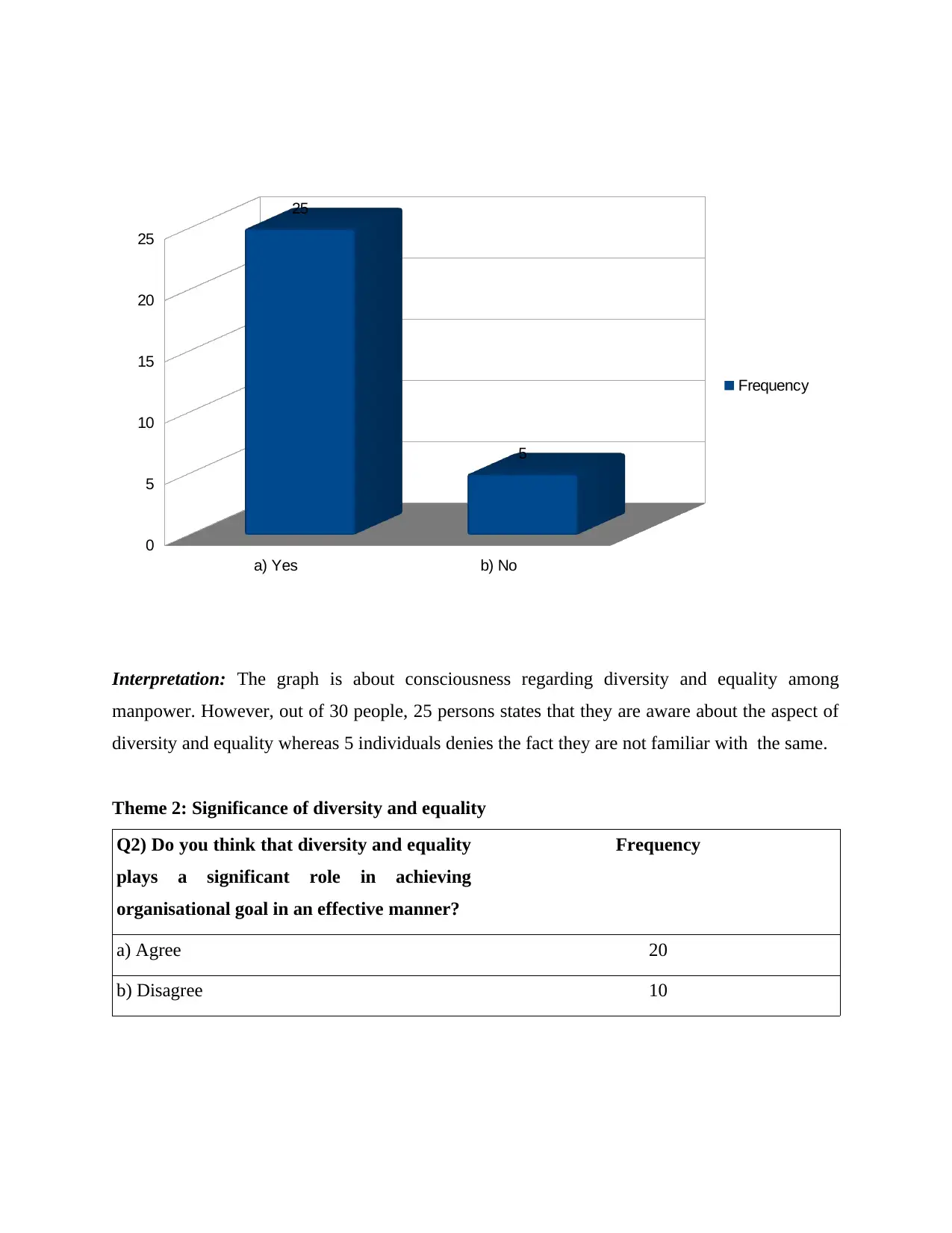
Interpretation: The graph is about consciousness regarding diversity and equality among
manpower. However, out of 30 people, 25 persons states that they are aware about the aspect of
diversity and equality whereas 5 individuals denies the fact they are not familiar with the same.
Theme 2: Significance of diversity and equality
Q2) Do you think that diversity and equality
plays a significant role in achieving
organisational goal in an effective manner?
Frequency
a) Agree 20
b) Disagree 10
a) Yes b) No
0
5
10
15
20
25
25
5
Frequency
manpower. However, out of 30 people, 25 persons states that they are aware about the aspect of
diversity and equality whereas 5 individuals denies the fact they are not familiar with the same.
Theme 2: Significance of diversity and equality
Q2) Do you think that diversity and equality
plays a significant role in achieving
organisational goal in an effective manner?
Frequency
a) Agree 20
b) Disagree 10
a) Yes b) No
0
5
10
15
20
25
25
5
Frequency
⊘ This is a preview!⊘
Do you want full access?
Subscribe today to unlock all pages.

Trusted by 1+ million students worldwide
1 out of 28
Related Documents
Your All-in-One AI-Powered Toolkit for Academic Success.
+13062052269
info@desklib.com
Available 24*7 on WhatsApp / Email
![[object Object]](/_next/static/media/star-bottom.7253800d.svg)
Unlock your academic potential
Copyright © 2020–2025 A2Z Services. All Rights Reserved. Developed and managed by ZUCOL.





